Abstract
Nine men participated in two experiments to determine the effects of increased response requirement and alcohol administration on free-operant aggressive responding. Two response buttons (A and B) were available. Pressing Button A was maintained by a fixed-ratio 100 schedule of point presentation. Subjects were instructed that completion of each fixed-ratio 10 on Button B resulted in the subtraction of a point from a fictitious second subject. Button B presses were defined as aggressive because they ostensibly resulted in the presentation of an aversive stimulus to another person. Aggressive responses were engendered by a random-time schedule of point loss and were maintained by initiation of intervals free of point loss. Instructions attributed these point losses to Button B presses of the fictitious other subject. In Experiment 1, increasing the ratio requirement on Button B decreased the number of ratios completed in 4 of 5 subjects. In Experiment 2, the effects of placebo and three alcohol doses (0.125, 0.25, and 0.375 g/kg) were determined when Button B presses were maintained at ratio values of 20, 40 and 80. Three subjects who reduced aggressive responding with increasing fixed-ratio values reduced aggressive responding further at higher alcohol doses. One subject who did not reduce aggressive responding with increasing fixed-ratio values increased aggressive responding at the highest alcohol dose. The results of this study support suggestions that alcohol alters aggressive behavior by reducing the control of competing contingencies.
Full text
PDF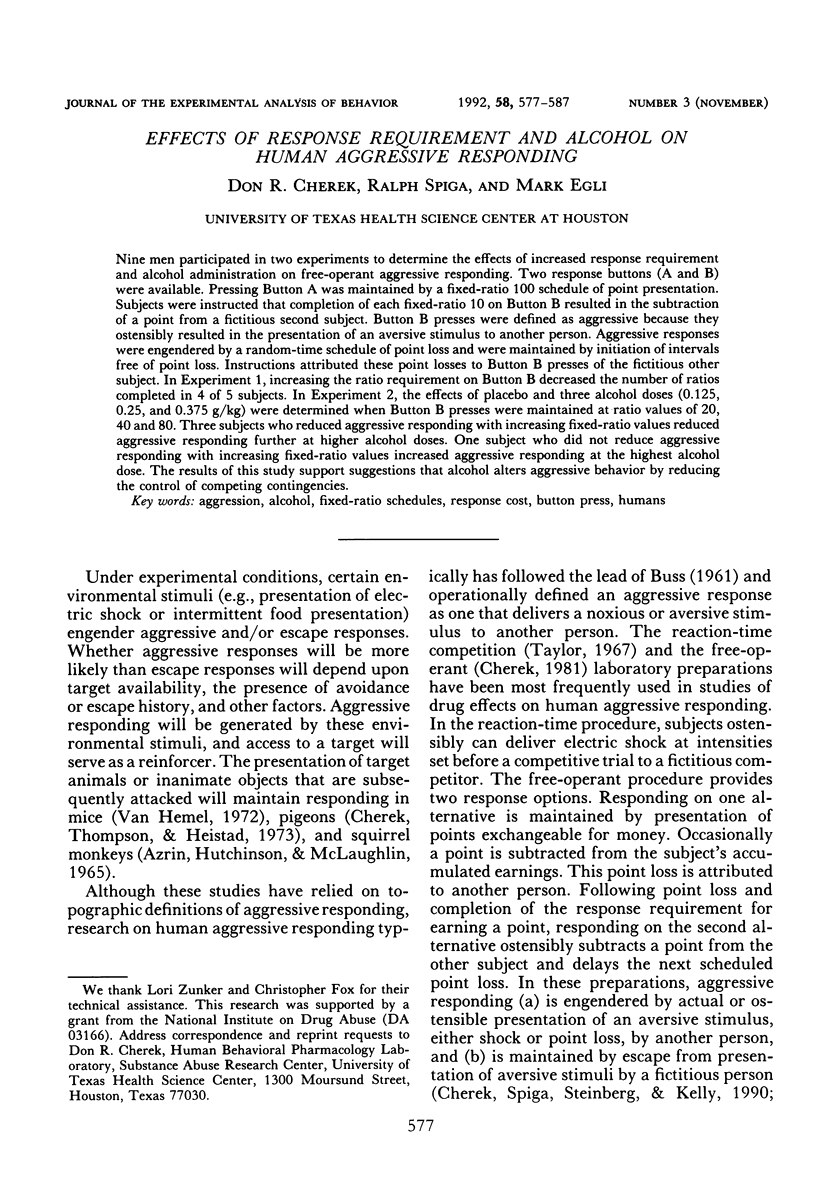

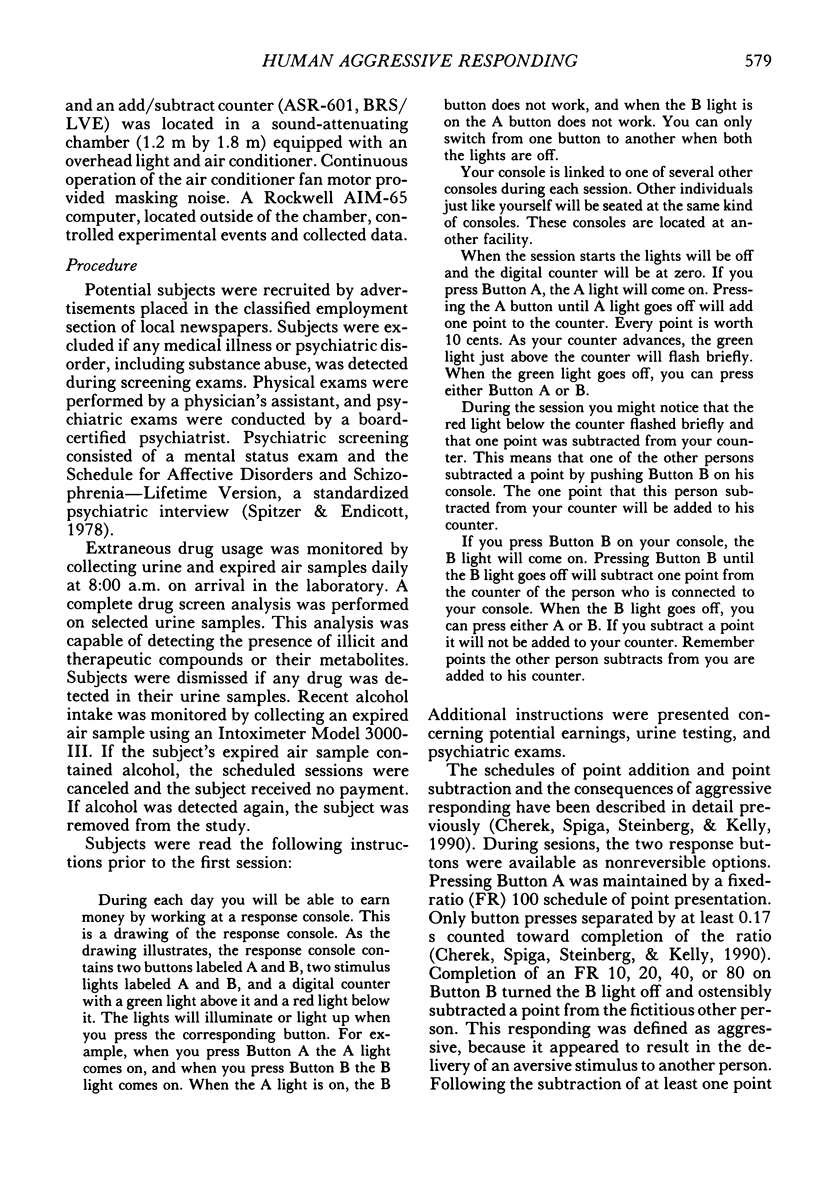

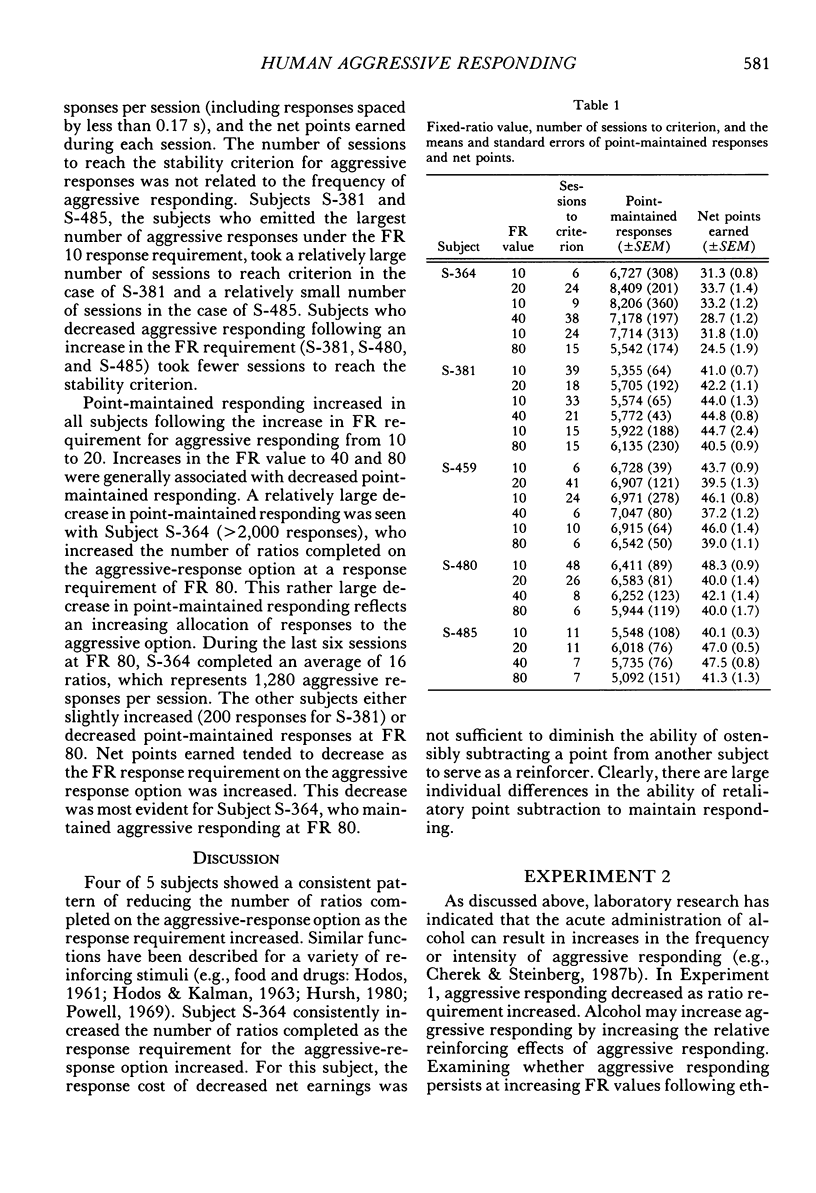
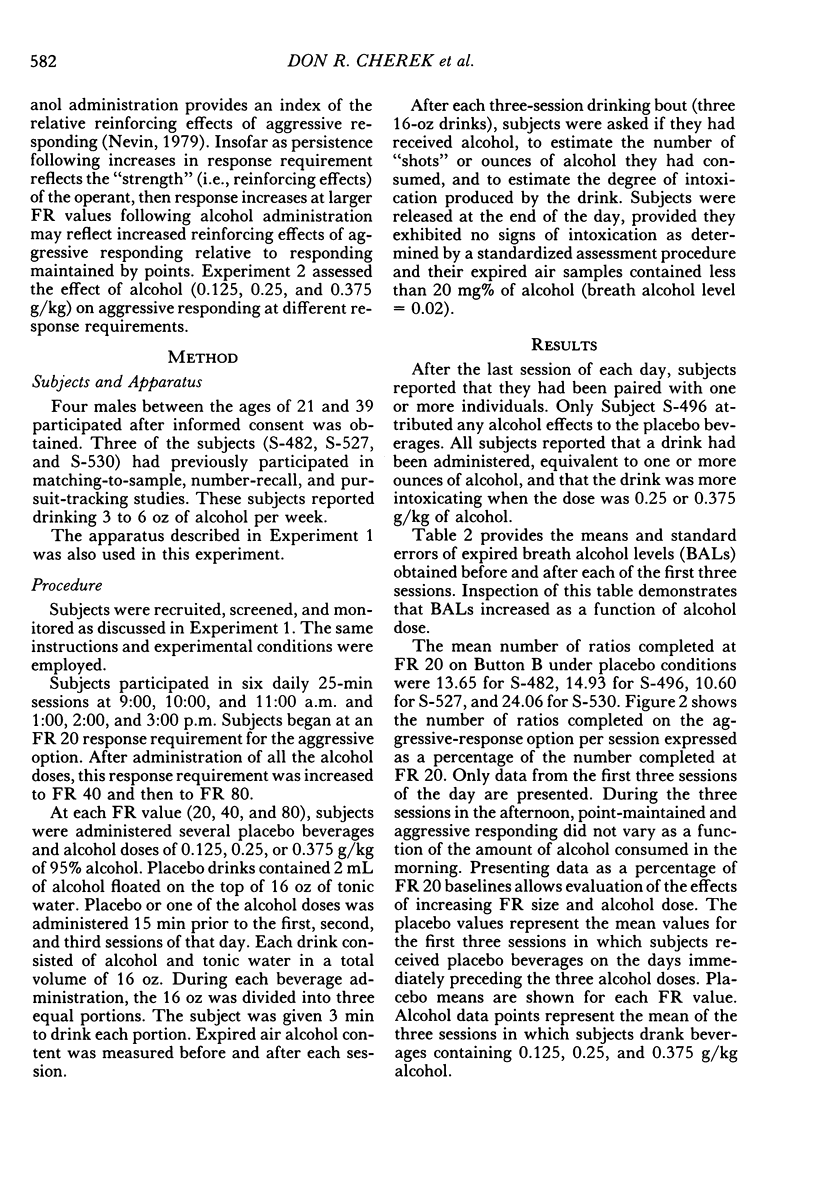
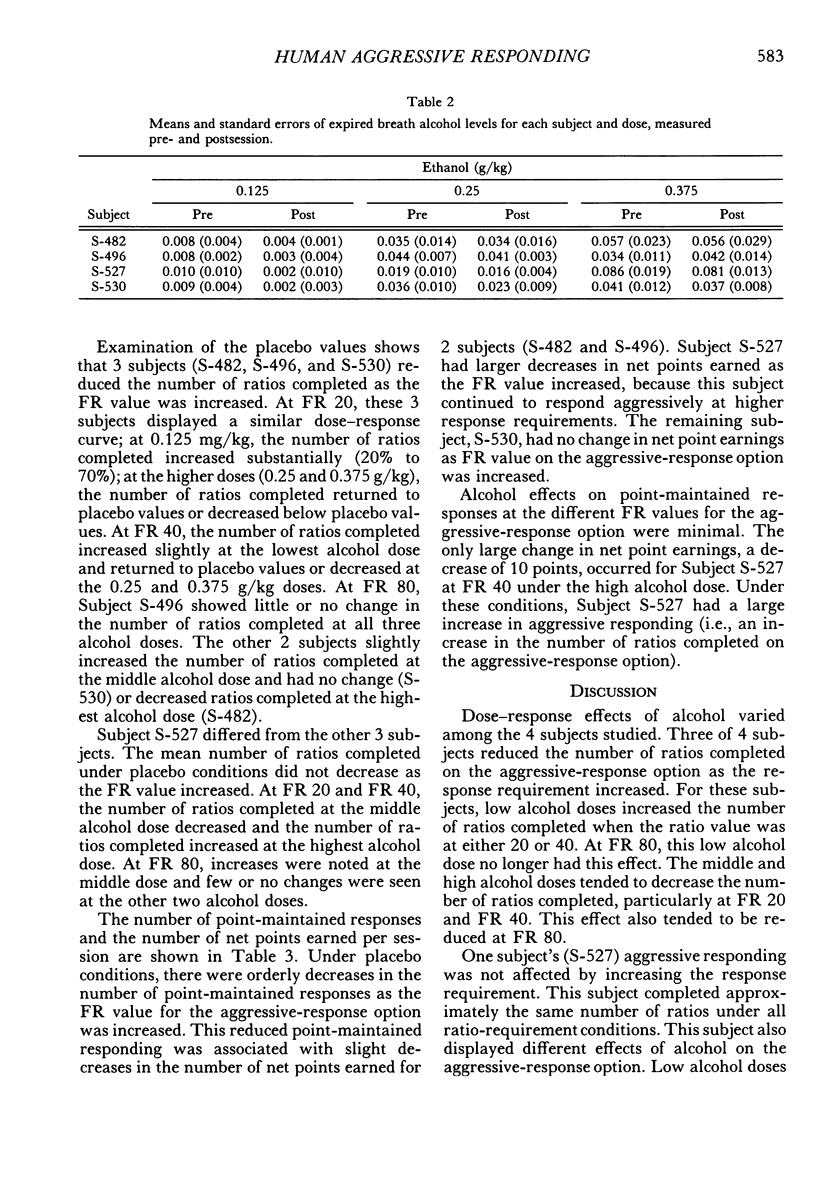
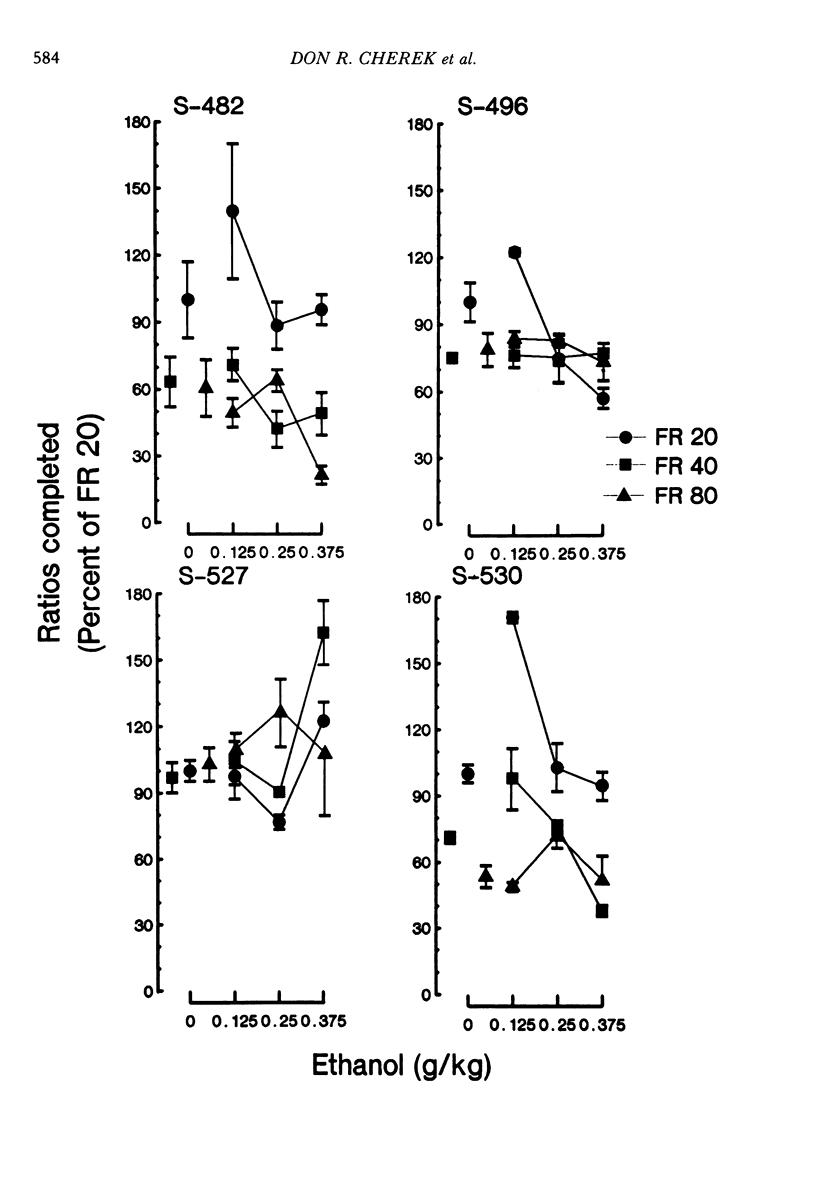
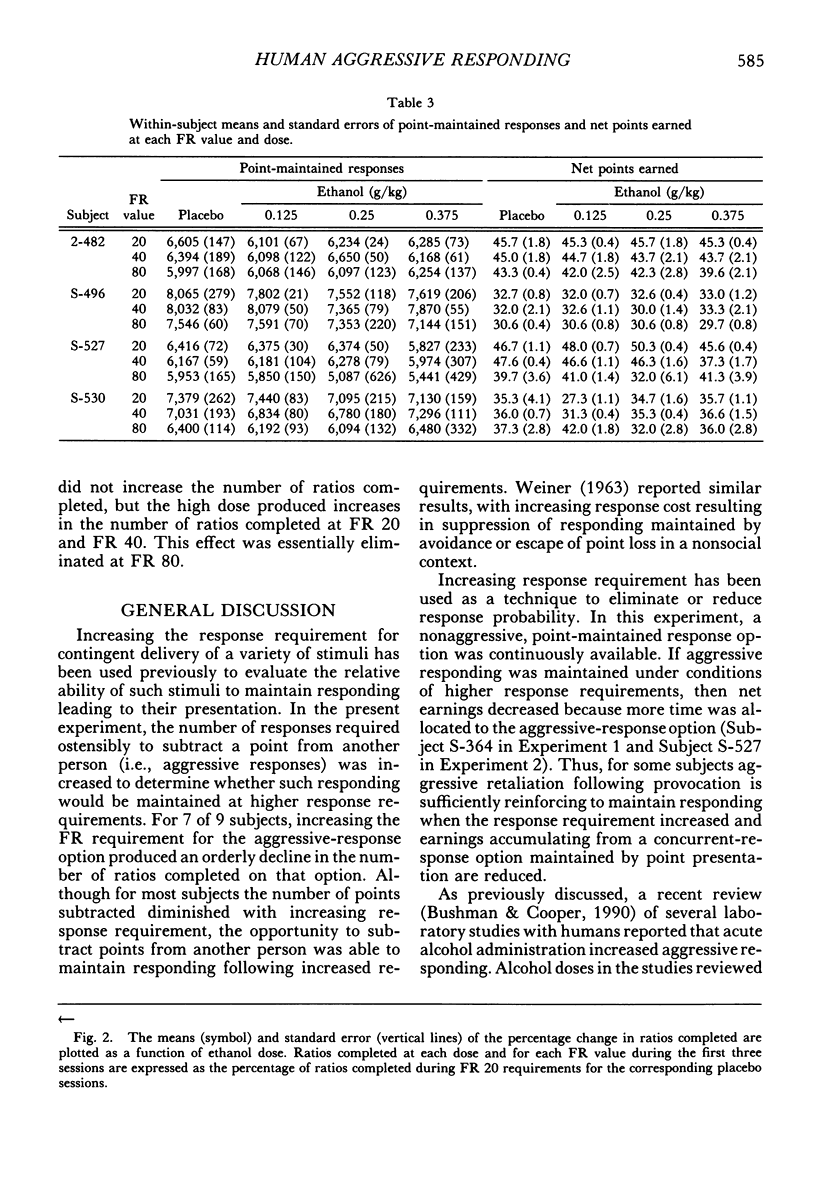

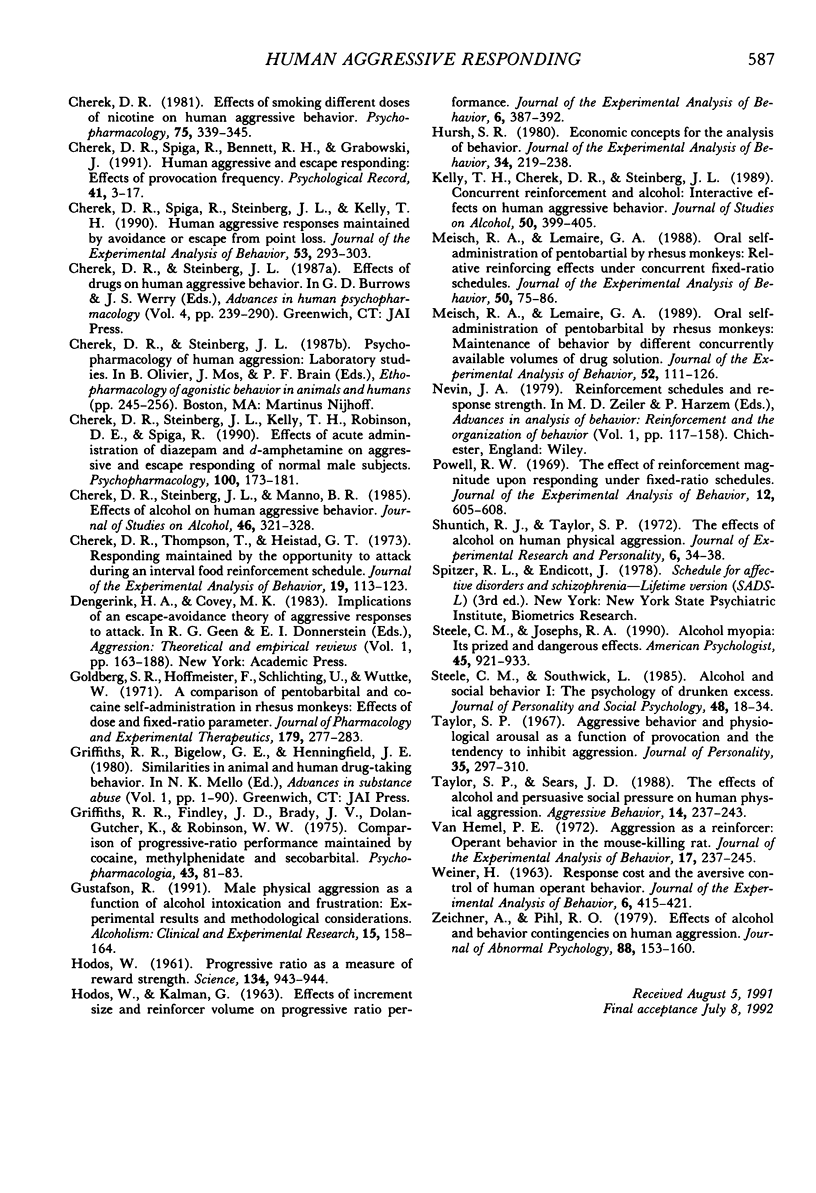
Selected References
These references are in PubMed. This may not be the complete list of references from this article.
- AZRIN N. H., HUTCHINSON R. R., MCLAUGHLIN R. THE OPPORTUNITY FOR AGGRESSION AS AN OPERANT REINFORCER DURING AVERSIVE STIMULATION. J Exp Anal Behav. 1965 May;8:171–180. doi: 10.1901/jeab.1965.8-171. [DOI] [PMC free article] [PubMed] [Google Scholar]
- Bennett R. M., Buss A. H., Carpenter J. A. Alcohol and human physical aggression. Q J Stud Alcohol. 1969 Dec;30(4):870–876. [PubMed] [Google Scholar]
- Bushman B. J., Cooper H. M. Effects of alcohol on human aggression: an integrative research review. Psychol Bull. 1990 May;107(3):341–354. doi: 10.1037/0033-2909.107.3.341. [DOI] [PubMed] [Google Scholar]
- Cherek D. R. Effects of smoking different doses of nicotine on human aggressive behavior. Psychopharmacology (Berl) 1981;75(4):339–345. doi: 10.1007/BF00435849. [DOI] [PubMed] [Google Scholar]
- Cherek D. R., Spiga R., Steinberg J. L., Kelly T. H. Human aggressive responses maintained by avoidance or escape from point loss. J Exp Anal Behav. 1990 Mar;53(2):293–303. doi: 10.1901/jeab.1990.53-293. [DOI] [PMC free article] [PubMed] [Google Scholar]
- Cherek D. R., Steinberg J. L., Kelly T. H., Robinson D. E., Spiga R. Effects of acute administration of diazepam and d-amphetamine on aggressive and escape responding of normal male subjects. Psychopharmacology (Berl) 1990;100(2):173–181. doi: 10.1007/BF02244402. [DOI] [PubMed] [Google Scholar]
- Cherek D. R., Steinberg J. L., Manno B. R. Effects of alcohol on human aggressive behavior. J Stud Alcohol. 1985 Jul;46(4):321–328. doi: 10.15288/jsa.1985.46.321. [DOI] [PubMed] [Google Scholar]
- Cherek D. R., Thompson T., Heistad G. T. Responding maintained by the opportunity to attack during an interval food reinforcement schedule. J Exp Anal Behav. 1973 Jan;19(1):113–123. doi: 10.1901/jeab.1973.19-113. [DOI] [PMC free article] [PubMed] [Google Scholar]
- Goldberg S. R., Hoffmeister F., Schlichting U. U., Wuttke W. A comparison of pentobarbital and cocaine self-administration in rhesus monkeys: effects of dose and fixed-ratio parameter. J Pharmacol Exp Ther. 1971 Nov;179(2):277–283. [PubMed] [Google Scholar]
- Griffiths R. R., Findley J. D., Brady J. V., Dolan-Gutcher K., Robinson W. W. Comparison of progressive-ratio performance maintained by cocaine, methylphenidate and secobarbital. Psychopharmacologia. 1975 Jul 23;43(1):81–83. doi: 10.1007/BF00437619. [DOI] [PubMed] [Google Scholar]
- Gustafson R. Male physical aggression as a function of alcohol intoxication and frustration: experimental results and methodological considerations. Alcohol Clin Exp Res. 1991 Mar;15(2):158–164. doi: 10.1111/j.1530-0277.1991.tb01847.x. [DOI] [PubMed] [Google Scholar]
- HODOS W., KALMAN G. Effects of increment size and reinforcer volume on progressive ratio performance. J Exp Anal Behav. 1963 Jul;6:387–392. doi: 10.1901/jeab.1963.6-387. [DOI] [PMC free article] [PubMed] [Google Scholar]
- HODOS W. Progressive ratio as a measure of reward strength. Science. 1961 Sep 29;134(3483):943–944. doi: 10.1126/science.134.3483.943. [DOI] [PubMed] [Google Scholar]
- Hursh S. R. Economic concepts for the analysis of behavior. J Exp Anal Behav. 1980 Sep;34(2):219–238. doi: 10.1901/jeab.1980.34-219. [DOI] [PMC free article] [PubMed] [Google Scholar]
- Kelly T. H., Cherek D. R., Steinberg J. L. Concurrent reinforcement and alcohol: interactive effects on human aggressive behavior. J Stud Alcohol. 1989 Sep;50(5):399–405. doi: 10.15288/jsa.1989.50.399. [DOI] [PubMed] [Google Scholar]
- Meisch R. A., Lemaire G. A. Oral self-administration of pentobarbital by rhesus monkeys: maintenance of behavior by different concurrently available volumes of drug solution. J Exp Anal Behav. 1989 Sep;52(2):111–126. doi: 10.1901/jeab.1989.52-111. [DOI] [PMC free article] [PubMed] [Google Scholar]
- Meisch R. A., Lemaire G. A. Oral self-administration of pentobarbital by rhesus monkeys: relative reinforcing effects under concurrent fixed-ratio schedules. J Exp Anal Behav. 1988 Jul;50(1):75–86. doi: 10.1901/jeab.1988.50-75. [DOI] [PMC free article] [PubMed] [Google Scholar]
- Powell R. W. The effect of reinforcement magnitude upon responding under fixed-ratio schedules. J Exp Anal Behav. 1969 Jul;12(4):605–608. doi: 10.1901/jeab.1969.12-605. [DOI] [PMC free article] [PubMed] [Google Scholar]
- Steele C. M., Josephs R. A. Alcohol myopia. Its prized and dangerous effects. Am Psychol. 1990 Aug;45(8):921–933. doi: 10.1037//0003-066x.45.8.921. [DOI] [PubMed] [Google Scholar]
- Steele C. M., Southwick L. Alcohol and social behavior I: The psychology of drunken excess. J Pers Soc Psychol. 1985 Jan;48(1):18–34. doi: 10.1037//0022-3514.48.1.18. [DOI] [PubMed] [Google Scholar]
- Taylor S. P. Aggressive behavior and physiological arousal as a function of provocation and the tendency to inhibit aggression. J Pers. 1967 Jun;35(2):297–310. doi: 10.1111/j.1467-6494.1967.tb01430.x. [DOI] [PubMed] [Google Scholar]
- Van Hemel P. E. Aggression as a reinforcer: operant behavor in the mouse-killing rat. J Exp Anal Behav. 1972 Mar;17(2):237–245. doi: 10.1901/jeab.1972.17-237. [DOI] [PMC free article] [PubMed] [Google Scholar]
- WEINER H. Response cost and the aversive control of human operant behavior. J Exp Anal Behav. 1963 Jul;6:415–421. doi: 10.1901/jeab.1963.6-415. [DOI] [PMC free article] [PubMed] [Google Scholar]
- Zeichner A., Pihl R. O. Effects of alcohol and behavior contingencies on human aggression. J Abnorm Psychol. 1979 Apr;88(2):153–160. doi: 10.1037//0021-843x.88.2.153. [DOI] [PubMed] [Google Scholar]


